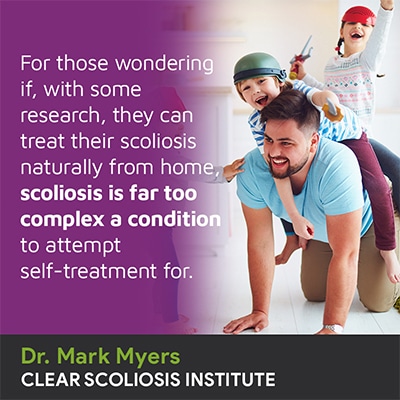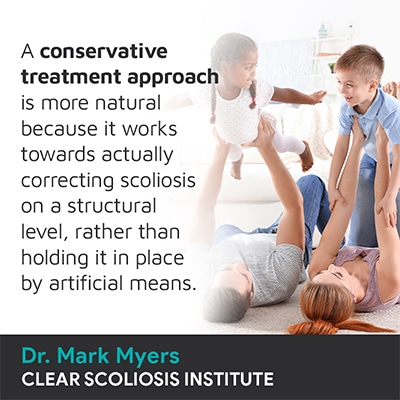
When patients ask how to straighten their spines naturally, this can mean different things to different people. Ranging from DIY home-treatment to holistic methods, most questions involve whether nonoperative treatment is an option. When it comes to scoliosis, there are two main treatment approaches, each offering patients a different potential outcome; continue reading to understand the key differences.
While traditional scoliosis treatment tends to end with a surgical recommendation, there is a nonsurgical treatment option that offers patients a less-invasive approach: conservative chiropractic-centered treatment that has the end goal of preserving natural spinal function and strength.
Before getting to the key differences between traditional and conservative treatment, let’s first define scoliosis and discuss some important condition features.
Scoliosis is a structural spinal condition that involves the development of an unhealthy and unnatural spinal curve.
With the loss of an unhealthy spinal curve, the spine’s overall strength, function, and biomechanics are disrupted, and this is because the spine’s healthy curves increase its strength, flexibility, and ability to handle mechanical stress.
Scoliotic curves can develop in any of the spine’s sections (cervical, thoracic, and lumbar) and are lateral (sideways) curves that include rotation.
So scoliosis doesn’t just cause the spine to bend unnaturally to the side, it also twists, which is why scoliosis is considered a complex 3-dimensional condition.
Scoliosis is also progressive, meaning that scoliotic curves are virtually guaranteed to increase in size over time.
So where a scoliosis is, in terms of severity, at the time of diagnosis, doesn’t mean that it will stay there and/or not get worse.
When the spine’s healthy curves are in place, it’s aligned, meaning its vertebrae (bones) are stacked on top of one another, but as an unnatural curve develops, some vertebrae become tilted, shifting them out of alignment with the rest of the spine.
A key measurement known as Cobb angle, determined during X-ray, tells me how far out of alignment a patient’s spine is, and the higher the Cobb angle, the more severe the condition.
Cobb angle measurements of between 10 and 25 degrees are classified as mild scoliosis, while measurements of between 25 and 40 degrees are considered moderate, with 40+ degrees classified as severe.
A patient’s severity level, along with other factors such as patient age, curvature location, and condition type further classify conditions at the time of diagnosis, and these classification-points are what customized treatment plans are designed around.
Now that we’ve explored some key condition features, let’s move on to the topic of treatment options, and whether or not it’s possible to straighten the spine naturally.
After a diagnosis of scoliosis has been given, the most important next step is deciding on the type of treatment to commit to; different treatment approaches offer different potential outcomes.
Scoliosis is a complex spinal condition that necessitates a customized treatment approach designed by a specialist.

While certain scoliosis-specific exercises can be performed at home and are indeed a facet of treatment, scoliosis is a structural condition, so the most important aspect of treatment is impacting it on a structural level.
In addition, as a progressive condition, being monitored closely is also a key component of treatment; while certain postural changes can be visible to the naked eye, what’s happening in and around the spine requires observation from every angle via X-ray, plus a series of complex measurements.
Careful monitoring via X-ray is particularly important when treating the condition’s most-prevalent form, adolescent idiopathic scoliosis, affecting those between the ages of 10 and 18, because rapid-phase progression can occur.
While we don’t fully understand the onset of idiopathic scoliosis, we do know what triggers its progression: growth.
Part of proactive treatment is preventing progression by closely monitoring a patient’s spine to see how it responds to treatment and growth, and then adjusting treatment plans accordingly.
Without the ability to closely monitor the spine through X-ray, patients attempting home treatment can be unaware their condition is getting worse, making it more complex to treat; with progression, the spine’s rigidity increases, making it less responsive to treatment.
With all of the tools we have available as CLEAR scoliosis doctors we would never consider using only stretching, or only exercises. It would be like trying to make a birthday cake with 2 of your favorite ingredients. In order to be treated effectively, scoliosis has to be impacted on multiple levels and treated by a specialist, so let’s move on to the two main scoliosis treatment approaches: traditional and conservative.
Traditional Scoliosis Treatment
Traditional scoliosis treatment was the dominant choice for many years, but that doesn’t mean it’s the only option, or the best one.
Traditional treatment is not proactive, it’s reactive; it doesn’t have a strategy for treating mild conditions so recommends watching and waiting, but as a progressive condition, it’s virtually guaranteed to get worse, so why hold off treatment?
If a patient crosses into the severe level and shows signs of continued progression, they become surgical candidates, which is how traditional treatment can funnel patients towards spinal fusion surgery; little is done beforehand to proactively prevent progressing to that point.
Spinal fusion surgery is an invasive procedure with the ultimate goal of stopping progression; its approach is to fuse the curve’s most-tilted vertebrae into one solid bone, and often, rods are attached to the spine with pedicle screws to hold it in place.
The spine’s very design is based on movement, so having a fused and immoveable section is contrary to that movement-based design.
The spine being fused and held in place by artificial means is not the same as working towards corrective results, which is the goal of conservative treatment.
Conservative Scoliosis Treatment
As a Clear-certified scoliosis chiropractor, I favor a conservative chiropractic-centered treatment approach that works towards preventing progression by starting treatment immediately following a diagnosis.
While treatment results can never be guaranteed, conditions that are detected early and responded to with proactive treatment are more likely to respond positively.
Scoliosis is the simplest to treat while mild, before the spine’s rigidity has increased with progression and before the body has had time to adjust to the unnatural spinal curve’s presence.
While each case is unique, the CLEAR Scoliosis Institute’s approach includes some preparatory work to ensure the spine and its surrounding muscles are going to be at their most responsive to treatment: warm-up exercises, massage, and a variety of therapies can relax the spine and its surrounding muscles.
Once the spine is ready for treatment, its structure is focused on.
As a structural condition, scoliosis has to be impacted on a structural level, and this is worked towards through condition-specific chiropractic care that can include a variety of chiropractic techniques and precise manual adjustments.
Chiropractic care can help reposition the most-tilted vertebrae back into alignment with the spine, restoring as much of its natural curves as possible, while improving its biomechanics.
By changing the actual structure of the spine, this is achieving corrective results in the form of a curvature reduction.
The next phase of treatment involves a series of scoliosis-specific exercises that can improve posture, balance, coordination, and strengthen the muscles surrounding the spine so they can provide it with optimal support and stabilization; these can also help improve brain-body communication so a more natural and balanced body position is achieved.
So as you can see, the goal is to impact scoliosis on multiple levels, and in order to do so, multiple treatment disciplines are integrated into customized treatment plans.

As a progressive structural spinal condition, how a diagnosis of scoliosis is responded to with treatment can have far-reaching effects.
When it comes to being proactive with treatment, this means starting treatment as close to the time of diagnosis as possible, when the condition is at its mildest and going to be the most responsive.
For those interested in non-invasive home treatment, scoliosis is simply too complex to be treated by anyone other than a specialist; X-ray imaging is also needed so treatment plans can be shaped around how the spine is responding to treatment and growth.
Those who choose to commit to a traditional treatment approach can be funneled in the direction of spinal fusion surgery, known to cost the spine in terms of its natural function and strength; a conservative treatment approach strives to preserve as much of the spine’s natural function as possible by working towards corrective results.
So is it possible to straighten the spine naturally: yes, with treatment that works towards correcting scoliosis by reducing curves on a structural level and increasing the spine’s surrounding muscle strength.
Conservative treatment prioritizes the spine’s natural strength and function, which is why it seeks to restore the spine’s natural curves and support.

CLEAR provides a unique and innovative way of understanding scoliosis. Sign up to receive facts and information you won’t find anywhere else.
